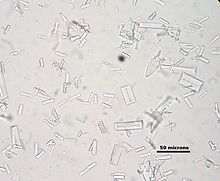
Back Estruvita Catalan Struvit German Amonia magnezia fosfato Esperanto Estruvita Spanish Struvita Basque Struvite French Struvite Italian ストルバイト Japanese Struviet Dutch Struwit Polish
| Struvite | |
|---|---|
 Crystals of struvite from dog urine | |
| General | |
| Category | Phosphate mineral |
| Formula (repeating unit) | NH4MgPO4·6H2O |
| IMA symbol | Suv[1] |
| Strunz classification | 8.CH.40 |
| Crystal system | Orthorhombic |
| Crystal class | Pyramidal (mm2) H-M symbol: (mm2) |
| Space group | Pmn21 |
| Identification | |
| Color | Colorless, white (dehydrated), yellow or brownish, light gray |
| Crystal habit | Euhedral to platy |
| Twinning | On {001} |
| Cleavage | {100} perfect |
| Fracture | Uneven |
| Mohs scale hardness | 1.5–2 |
| Luster | Vitreous to dull |
| Streak | White |
| Diaphaneity | Transparent to translucent |
| Specific gravity | 1.7 |
| Optical properties | Biaxial (+) 2V Measured: 37° |
| Refractive index | nα = 1.495 nβ = 1.496 nγ = 1.504 |
| Birefringence | δ = 0.009 |
| Solubility | Slightly soluble, dehydrates in dry, warm air |
| Other characteristics | Pyroelectric and piezoelectric |
| References | [2][3][4] |
Struvite (magnesium ammonium phosphate) is a phosphate mineral with formula: NH4MgPO4·6H2O. Struvite crystallizes in the orthorhombic system as white to yellowish or brownish-white pyramidal crystals or in platy mica-like forms. It is a soft mineral with Mohs hardness of 1.5 to 2 and has a low specific gravity of 1.7. It is sparingly soluble in neutral and alkaline conditions, but readily soluble in acid.
Struvite urinary stones and crystals form readily in the urine of animals and humans that are infected with ammonia-producing organisms. They are potentiated by alkaline urine and high magnesium excretion (high magnesium/plant-based diets). They also are potentiated by a specific urinary protein in domestic cats.
- ^ Warr, L.N. (2021). "IMA–CNMNC approved mineral symbols". Mineralogical Magazine. 85 (3): 291–320. Bibcode:2021MinM...85..291W. doi:10.1180/mgm.2021.43. S2CID 235729616.
- ^ "Struvite" (PDF). Handbook of mineralogy.
- ^ "Struvite Mineral Data". Webmineral.
- ^ "Struvite". Mindat.